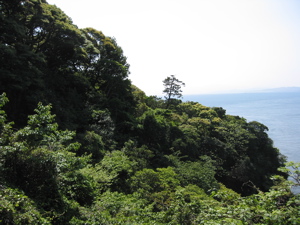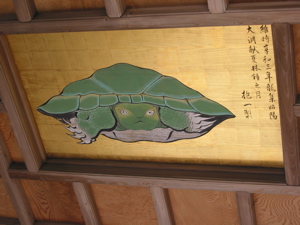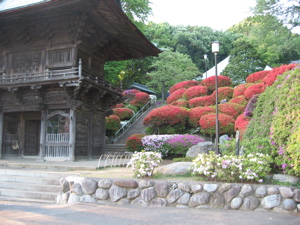
May 16th 2006
Loads to report this time. Taking things out of order, first the less pleasant event: I had an asthma attack, quite a bad one. Bad enough that I couldn't really stand up, and walking more than a few tens of metres was impossible. It is, according to my mother, over twenty five years since I had one so bad, and I rather hope it will be over twenty five years (well over) before the next one, because it was really rather unpleasant.
Yuriko was very helpful, though, finding the nearest respiratory doctor (two minutes' walk), and then going with me to the surgery, which was nice for moral support. I've probably mentioned before that Japan does not have GPs. All doctors are specialists, so you start out by going to someone who specialises in what seems to be wrong with you. Hospitals are more general, but I think they manage it by having a range of specialists on staff, rather than some generalists. In a lot of ways, this system makes sense; it reduces the burden on front-line doctors, and means that they are more likely to be aware of all the possibilities for what could be wrong for you. Of course, the problem could be deciding where to go. Fortunately, at least some local authorities (like ours, for example) run helplines, where you tell them your symptoms and they tell you which doctors would be good.
Anyway, the doctor did a couple of simple tests and determined that I was indeed having a bad asthma attack. (Peak flow less than a third of normal, heart rate somewhere around 110 as my body tried to get oxygen distributed.) This was good to know; it's so long since I've had one that it wasn't at all obvious. I was shunted off to a side room with a nebuliser for a while, which made things a lot easier, and then he prescribed me a vast amount of medicine: three sets of anti-inflammatory pills, one set of adiuvant pills, a set of anti-fever pills (as I had a fever at the time), two types of inhaled powder, and an emergency inhaler. I felt like I was going to open my own pharmacy.
The pharmacy, incidentally, was upstairs from the doctor, in the same building. A few years ago, Japanese doctors used to sell drugs, but that led to conflicts of interest, and was banned. Now they just all seem to have convenient pharmacies right next door. You can, of course, go to any pharmacy, but the convenient one stocks all the medicines that the doctor prescribes, and is very convenient, so it tends to win out. So, I got all my bubbles strips of pills (exactly enough for the prescribed dose and period), and started taking them in the evening. My fever was gone by the next day, and the asthma is a lot better. I'm still not completely right, but I'm much, much less ill than I was.
My general impression of the Japanese health care system is that it works fairly well. I'm in the national health insurance scheme, which means that I have to pay 30% of the costs of any treatment, but that there is an annual limit on the amount I can be asked to pay. The premiums are based on my income in the previous year, which meant that they were very cheap in my first year in Japan. It can be a problem if your income drops sharply, but I assume that there are rules for that. (The premiums are also tax-deductible, as well as being a form of tax themselves.)I believe some US healthcare providers complain that it is not liberal enough to allow them to move in and make enormous profits, but I suspect that's a good thing. Certainly, they'd find it hard to improve on zero waiting time to see a doctor, which is roughly what the current system generally provides.
So, I'm getting better now, and taking things a little easy on the work front for a few days, to give my body chance to recover. A complete holiday would be excessive, and financially painful; I did actually cancel my English lessons on Saturday, for the first time ever. But, talking of holidays, we've just had Golden Week, which was much more pleasant.
Yuriko had the public holidays and the weekend off, so we planned a few day trips, with the intent of taking them on days when the weather seemed appropriate. In the end, that worked out perfectly. Yuriko's brother Kouji was staying with us for a few nights during the week, as he had a sketching trip to Niigata, which is in the northwest of Japan, and that would be a long journey direct from Nagoya. So, he stayed one night on the way up, and then two nights on the way back, to give himself some time in Tokyo. As a result, we only really saw him in the evenings, but that was still nice; I don't get many opportunities to talk to him.
 The view from the path up one side of Enoshima.
The view from the path up one side of Enoshima.
The first of our day trips was to Enoshima, which is sort-of like a Japanese version of Mont-St-Michel. It's an island that used to be joined to the mainland at low tide, and now has a permanent bridge. There is a triple shrine on the island, with an outer, middle, and inner shrine, and all kinds of touristy stuff, much of which has been there for years, in some form or another. We went on the Wednesday, and the weather was absolutely perfect; blue sky, sunny, but not too hot. Indeed, on the coast the wind was occasionally a bit chilly. The train journey there was fine, and actually quite simple once we'd tracked down the best route. The walk from the station to the island was also fairly short, but the number of people had increased.
As soon as you set foot on the island, you are in tourist-trap territory. There is a narrow road leading up to the main entrance to the outer shrine, and it is lined with shops selling, ahem, things that tourists are likely to buy. On a bright day in Golden Week, it was also heaving with people. Fortunately, after we got to the top of the street, our preferred route took us along a smaller path around the side of the island, where there weren't so many people. That's the path I took the sea-view photograph from. That path rejoins the main route just a little below the inner shrine, and very close to the restaurant Yuriko had chosen for lunch. The restaurant served the specialities of the island, which were seafood, and quite nice, but also had a wonderful view out over the ocean. We had a bit of a wait before lunch, because they were quite busy, so walked around a bit, but we saved most of our exploring for afterwards.
 Hello! The turtle on the ceiling of the inner shrine at Enoshima.
Hello! The turtle on the ceiling of the inner shrine at Enoshima.
Given where we were, our first visit was to the inner shrine. The kami enshrined on Enoshima are primarily three goddesses from Kyushu, responsible for trade and travel. The inner shrine also includes a shrine to a dragon, who reputedly caused lots of trouble on the island until tamed by the love of a good woman. The symbol of the shrine is a representation of a scale of the dragon, reputedly dropped at some point during the legend. Another important symbol of the island is the turtle, the sacred animal of the goddesses. The ceiling of the worship hall of the inner shrine has a famous, and rather unusual, picture of a turtle. Turtles are symbols of long life and good fortune in Japan, rather like the crane, although slightly less popular over all.
The island has also become associated with Benzaiten, a goddess originally from India who is, in Japan, responsible for the arts and romance. (It's entirely possible that, in India, she was a vicious demon who ate the hearts of sleeping babies. The Japanese have tended to thoroughly transform the things they import.) This means that there are quite a few couple things on the island, and while walking near the inner shrine, almost all the people we saw were young couples.
From the top of the island, we walked down a lot of steps to a beach. It's more of a stone shelf at the base of a cliff, actually; apparently the great Kanto earthquake lifted the ground a metre or so. It looks like it's covered at high tide, because there are a number of tidal pools, some of them very deep. The whole area is pleasant, with cliffs to one side and the ocean to the other. It's also the way to two large caves with a long religious history.
These have been thoroughly developed, complete with plastic roaring dragon, glow-in-the-dark rocks, and huge amounts of plastic sheeting over the ceiling. Now, as a rock fell off the roof and bounced noisily off the guard plastic while we were there, I'm not about to deny the need for safety measures. However, giving everyone a helmet and padded jacket would, I think, be much better; it would preserve the sense of adventure, and allow you to actually see the caves, which must have been quite spectacular, before.
From there, we headed back the way we came, to explore the rest of the island. This was even more full of people, but it was nice to see the other shrines. There's a garden on the peak, with an observation tower, but we didn't have time to go in there, especially as it was pay-for-admission. We didn't have a lot of time to linger, but on the tourist road we did line up for marutakoyakisembei, which Yuriko wanted to eat. This is a speciality of the particular shop, and is made by dipping about ten small octopuses in rice flower, putting them on a hot plate, and then squeezing them, hard, with another hot plate from above. The result is paper-thin, and rather tasty.
The next day, we went to Kawasaki. A really easy trip. The main visit was to the city museum, which had an exhibition of photographs of Kawasaki taken over the course of fifty years. Fifty years ago, this was a rural area. There are still, as I have mentioned, bits where you can feel that, but the urban sprawl has largely conquered. The photographs also showed local events and people, and important historical artefacts unearthed. It was very interesting, and the museum cafe was also rather better than museum cafes often are. Not "Wow, must recommend it to all my friends" good, but "If you're at the musem, eat at the cafe" good. Not too expensive, nice food, nice environment (the museum is in a large park, and the cafe has a view), and convenient. We also had a quick look at some of the permanent exhibits, and the bookshop. I think we'll be going back at some point, to have a look at the bits we missed, and I might buy some of the books.
 The outer gate and the azaleas at the Azalea Temple.
The outer gate and the azaleas at the Azalea Temple.
On the way back, we got off the bus a couple of stops early to visit a local temple, which is also known as "Azalea Temple". It is built in a natural bowl in the hills, and the slope up the hill to the main hall is covered with azaleas. Naturally, they were in bloom. It was quite spectacular, and the local topography meant that, unless you looked straight out of the bowl, you could not really see the city. The Buddha worshipped there is a healing Buddha, so there were a lot of 'thank you' plaques displayed in the rest area. This is only about ten minutes' walk from our flat, so if we have visitors in late April or early May, it is a must visit.
After a day for cleaning around the flat, doing laundry, and generally taking it easy (good day!), we went to the National Museum of Japanese History on the Sunday. The main reason for going was their special exhibition, on Japanese shrines. This covered four major shrines, different aspects of each one, and was very interesting. There were bronze votive objects from about 1600 years ago, which were unearthed very recently, and discussions of the changing shape of Izumo Taisha. The shrine is rebuilt every so often, and the styles, and height, of the main shrine have changed substantially. Archaeology has recently unearthed evidence that the main shrine building was raised on a very high platform (10 metres plus). The shrine is also planning another rebuilding, the first for about fifty years. I wonder how high they want to go?
Then there was small section on Ise Jingu, before a room on Itsukushima Jinja, on Miyajima. This talked about the typhoon damage I saw while I was there, but also about the structure of the shrine and the work necessary to keep it in good shape despite the fact that it is permanently standing in sea water and occasionally gets very flooded. The last room was on Yasaka Jinja in Kyoto, and the Gion Matsuri, which is a very large festival, famous for extremely large floats. By this time, museum fatigue was setting in, so we looked round quite quickly before going to the museum restaurant for lunch. This was nice, once again, and after lunch we went for a quick look round the permanent exhibitions.
These are dominated by reconstruction models of cities or typical buildings from various periods in Japanese history, in a number of scales. They looked fascinating, and it's a shame we only had time for a quick whip round. We'd like to go back, but it's in Chiba Prefecture, near Narita airport, so the journey time is long. I suspect it will need another interesting special exhibition to lure us out.
After Golden Week, I had a cold, which was almost certainly a major contributor to the astham attack. And that brings us back to up to date.